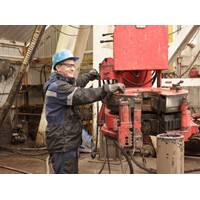Who Will Pay for the Energy Transition?

The transition from a fossil-fuel dominated energy system to one with zero emissions would require trillions of dollars of investment in new production, distribution and consumption equipment worldwide.New investments could support millions of new jobs in construction and manufacturing, but policymakers are struggling to decide whether to recover the costs from consumers or taxpayers.In most countries…
As Oil Prices Surge, US Eyes Growing Labor Shortage

Finding roughnecks remains a challenge for oil drillers as rising crude prices increase demand for their services, oilfield executives said on Thursday at a conference in Houston.Oilfield service suppliers cut tens of thousands of workers following the 2014 oil-price collapse, and skilled employees have moved to other industries or are no longer interested. A worker shortage is helping drive up service costs for oil producers…
Five Missing after Oklahoma Oil & Gas Blast
Five workers were missing after a fiery explosion on Monday at an oil and gas drilling site in eastern Oklahoma, officials said. The fire had been fed by gas from a well being drilled for Red Mountain Energy by Patterson-UTI Energy Inc, preventing a full search of the scene throughout the day, but was later extinguished, the Pittsburg County Emergency Management Department (PCEMD) said in a statement.
Drilling Costs Rise Along with U.S. Oil & Gas Activity
U.S. oil and gas drilling costs have started to rise in response to a surge in activity and are set to increase further as the slack in the rig market declines. Drilling costs increased by 7 percent between November 2016 and March 2017, according to preliminary data on producer prices from the U.S. Bureau of Labor Statistics. The increase has offset only a small part of the 34 percent slump between March 2014 and November 2016 (http://tmsnrt.rs/2q6RNzc).
Oil Industry Costs Will Rise as Focus Shifts to Growth

Oil industry costs are notoriously pro-cyclical, which is one of the main reasons for the pattern of boom and bust that has afflicted in the industry from the beginning. The cost of everything from skilled and unskilled labour to engineering contracts, field services, raw materials, equipment, spare parts and rig hire tends to rise and fall with price of oil. During a boom…
US Energy Jobs Rise as Higher Prices Boost Oil Drilling

U.S. oil and natural gas producers added jobs in December and January as drillers continued to return to the well pad with crude prices holding near 18 month highs, according to U.S. jobs data on Friday. Oil and gas extraction jobs increased by 100 to 177,400 in January, while support services jobs increased by 600 to 195,200 in December, its second increase in a row, according to U.S. Bureau of Labor Statistics (BLS) data.
US Energy Jobs on the Rise

U.S. oil and natural gas producers added jobs in November, the sector's first monthly employment increase in more than two years as drillers returned to the well pad due to a rally in crude prices, according to U.S. jobs data on Friday. Combined oil and gas extraction and support services jobs increased by 3,300 to 384,300 in November, the first increase since September 2014 when employment in the sector peaked at 536,100, according U.S.
U.S. Oil & Gas Sheds 100K Jobs in Slump
The number of people employed in oil and gas extraction and support activities across the United States has fallen by around 100,000 since October 2014. Between October 2014 and November 2015, the number of people on the payroll of oil and gas extraction firms and support services fell by almost 87,000, according to the U.S. Bureau of Labor Statistics (BLS). But once data on job losses in December and January becomes available…
Oil shock Impacting U.S. Economy: Kemp
Slumping oil and gas prices and a downturn in investment are proving to be major headwinds for the economies of the United States and other key important petroleum producers. Economists tend to think of oil and gas as simply an input into the production process for other goods and services, which is why they tend to think of falling fuel prices as a positive influence on economic activity.
U.S. Jet Fuel Demand Soars
Fuel consumption by U.S. airlines is growing at some of the fastest rates for a decade, according to data published by the federal government. U.S. carriers consumed 1.6 billion gallons of fuel in July, up 3.4 percent from the same month a year earlier (http://link.reuters.com/qad75w). Fuel consumption for the first seven months of the year rose nearly 2.9 percent, the biggest increase since 2011 and before that 2005, according to the U.S.
Kemp: U.S. Fuel Demand Levels Off
The initial consumption stimulus from lower oil prices may be fading, at least in the United States, according to the latest round of official data on traffic volumes and fuel sales. Traffic on California's highway network was 2.6 percent higher in May than a year earlier, the state transportation department said. Growth was the same as April's but lower than in March and February, and not much different from the long-term average of 2.5 percent.
U.S. Set to for More Accurate Oil Production Data
Figures on U.S. oil production are subject to much more uncertainty than the numbers for oil stocks, refinery throughput and imports because the Energy Information Administration (EIA) has to rely on state-level data rather than its own surveys. That could be about to change, however, because the EIA has received approval from the White House to launch its own mandatory monthly survey of oil and condensate production.
US Oilfield Jobs Coninue Unabated
When Ian Sandlin was laid off last week after 13 months working on oil rigs in southeast Texas, he was surprised to have lasted that long. "I knew it was coming," he said. The 27-year-old Houston native is among thousands of workers caught in an accelerating cull of oil field jobs across the once booming U.S. oil industry. Sandlin has since found other off-field work, but his hours and pay have been cut in half and it was not clear how long it would last.
US Oilfield Jobs Cull Gains Pace, More Pain Ahead
When Ian Sandlin was laid off last week after 13 months working on oil rigs in southeast Texas, he was surprised to have lasted that long. "I knew it was coming," he said. The 27-year-old Houston native is among thousands of workers caught in an accelerating cull of oil field jobs across the once booming U.S. oil industry. Sandlin has since found other off-field work, but his hours and pay have been cut in half and it was not clear how long it would last.
U.S. Businesses Brace for Oil Downturn
Oil and gas production is fundamental to the U.S. economy. The sharp downturn in prices will have a negative impact on business investment in the short term before the positive impact on consumer spending takes over further down the line. Oil and gas producers accounted for almost $1 in every $8 of new business investment in the U.S. economy in 2013, according to new data published by the Census Bureau.
Crude Oil Free Trade is in US Interests
U.S. oil refiners have been among the biggest beneficiaries of free trade in the last decade, so it is ironic some continue to lobby hard to maintain the protectionist ban on crude exports. Domestic consumption of oil-based products fell by just over 2 million barrels per day (b/d) between 2005 and 2013, according to the U.S. Energy Information Administration. Refiners turned to export markets to fill the gap…
Houston May Outgrow its Skilled Labor Supply
Bustling Houston, one of the bright spots in the U.S. economy, is growing so fast that business leaders fear running out of skilled labor as billions are spent building new energy infrastructure on the Gulf Coast. The Greater Houston Partnership, the business chamber for the 10-county region, on Monday launched a training plan with companies, junior colleges, high schools…
Rail Capacity Crisis Benefited Trucking
As a polar vortex snarled North America's railroads and upended freight flows this winter, everyone from agricultural giant Cargill to Dow Chemical rushed to secure the next-best form of hauling goods: trucks. In what trucking executives described as an unprecedented bidding frenzy, spot market rates surged by as much as 20 percent to record highs in the first three months of 2014 as shippers sought to minimize sometimes weeks-long delays in rail service.
